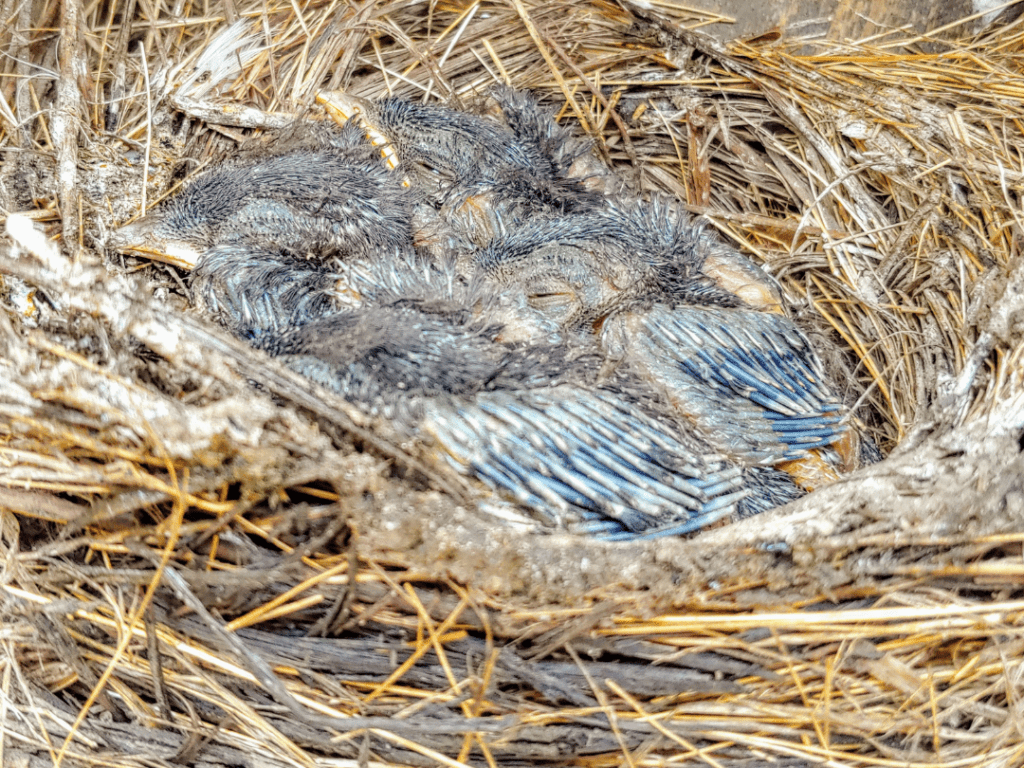It’s breeding season, and the blue jay hatchlings have arrived. They’re nesting in your local woods, garden, and neighborhood.
Whether you’ve just seen or rescued a baby blue jay, you want to ensure it’s eating correctly.
So let’s get this out of the way first: blue jays are omnivorous. Adult blue jays can eat insects, fruits, and vegetables, and the babies will usually eat any foods that the adults bring them — whether it be an insect or berry.

However, if you’ve rescued a baby blue jay or want to make sure the parent is bringing home something appropriate, you’ll want to know the specifics of what baby blue jays eat. Today, we’re going to answer some common feeding questions!
But that’s not all. We’ll also answer some other important questions about baby blue jays. So, let’s dive in.
Can Baby Blue Jays Eat Bananas?
Yes, baby blue jays can eat bananas. You can simply follow our guide on preparing bananas to find out how to slice them for birds. However, you’ll have to take more care when preparing bananas for hatchlings than for adult birds.
For example, the bananas must be ripened, as it’s softer for the baby blue jays to eat.
You also need to ensure the banana pieces are sliced into small cuts.
Unfortunately, we can’t give you exact measurements, as every baby blue jay is different — but look at the hatchling and make the best decision on an appropriate-sized banana slice.
Note: if in doubt, crush the banana instead of slicing it, so you can easily take small banana slithers and figure out what the baby will eat.
Can Baby Blue Jays Eat Blueberries?
Yes, baby blue jays can eat blueberries! This is a better option than bananas as blue jays love, love, love blueberries. However, like with bananas, cut the berry up first. While blueberries are small, they’ll still be too big for a hatchling.
Tip: Blueberries are a favorite choice for baby blue jays and come with various benefits, which we explore in the table below.
Benefit | Effect |
Vitamin B6 | Helps baby blue jays develop healthily. This one is essential for hatchlings. |
Potassium | Benefits a bird’s heart health and muscles. |
Folate | Supports a bird’s brain health. |
Vitamin C | Birds can produce vitamin C themselves, but having extra in their diet doesn’t hurt. Especially if they have a developing/unhealthy liver. |
Can Baby Blue Jays Eat Strawberries?
Yes, like with blueberries, baby blue jays can eat strawberries.
Fact: most berries with berry in the name are suitable for blue jays.
However, if you’re giving the bird scraps and have tossed your strawberries with sugar (or made them into a puree, added whipping cream, or anything like that), you shouldn’t give them to a baby blue jay).
Fat, salt, and sugar can all lead to health problems in birds. With a baby blue jay, we don’t need to stress the seriousness of that.
In short, ensure the strawberries are 100% natural and cut them into fine pieces that a baby blue jay can easily handle.
Can Baby Blue Jays Eat Grapes?
Yes, baby blue jays can eat grapes. However, like with the above foods, cut the grapes to an appropriate size before feeding them to blue jays.
This guide talks about the correct way to cut grapes for toddlers. However, it’s a similar concept for baby blue jays. You need to cut the grapes lengthways so they’re easy to swallow with a lessened risk of the baby blue jay choking.
However, the guide suggests cutting the grape into quarters for smaller babies. You should follow this same practice with blue jay hatchlings regardless of their size. You might even consider cutting the grape again after cutting it into quarters if it’s viable.
If you’re uncertain, you can also make grape jelly. However, don’t just follow the first recipe you find on Google. You need to follow a sugar-free recipe for the jelly to be appropriate for birds. Here’s an example of a guide you can follow:
Can Baby Blue Jays Eat Mealworms?
Yes! Not only can baby blue jays eat mealworms, but it’s one of the foods their parents are likely to bring home for them.
Mealworms are an excellent example of food you can easily get for your hatchling because you can order it in bulk online or from your local pet store.
When buying mealworms, most markets will sell them both dried or alive. It doesn’t matter which you get; a baby blue jay can eat both, but they might have an easier time with still-alive mealworms.
Here’s a video showing how to feed a baby blue jay mealworms:
More Baby Blue Jay Facts You Need To Know
You’re now ready to look after baby blue jays, but if you want to become an expert in birding, check out our other blog posts on Happy Birding. For example, we have an in-depth beginner’s guide to really teach you the ropes.
However, before we sign off, we thought we’d leave you with answers to a couple more common baby blue jay questions.
Can Baby Blue Jays Fly?
What Do Baby Blue Jays Sound Like?
Baby blue jays have a shrill, high-pitched chirp that will repeatedly sound in short spaces — especially if the baby blue jay is hungry. However, it’s nowhere near as loud as their parent’s cry.

James has always been an avid outdoorsman. Since a kid, he kept a journal of all the different birds and species he saw. Now he wants to share his passion with other birders with Happy Birding!
